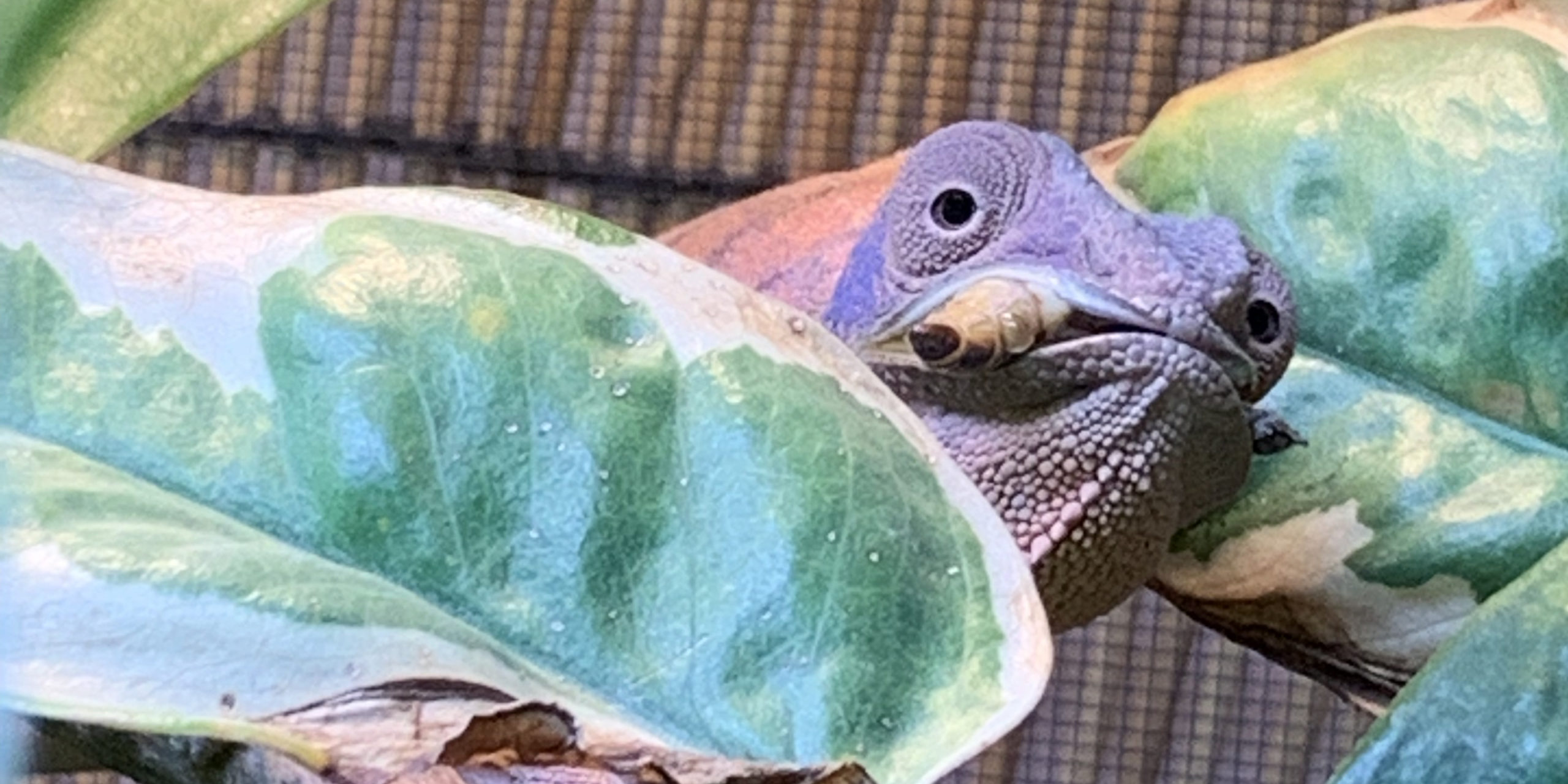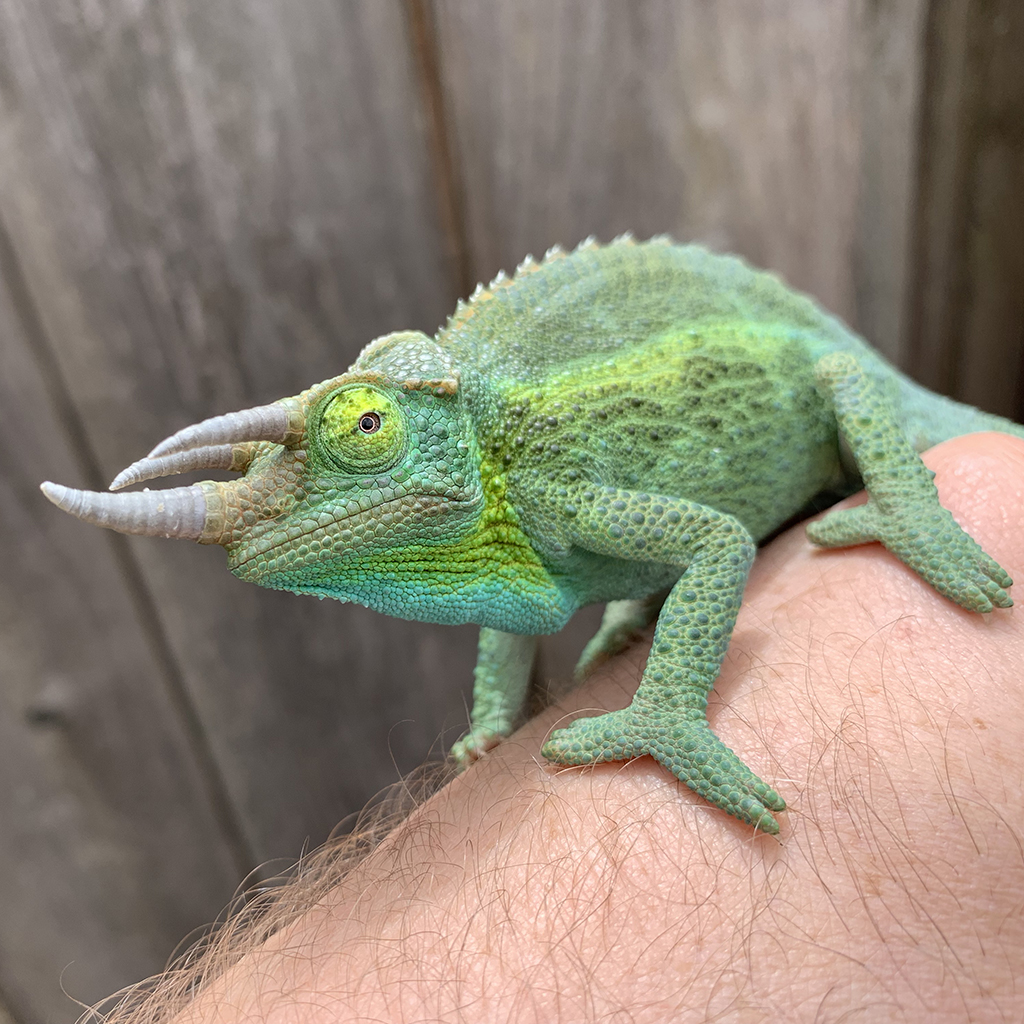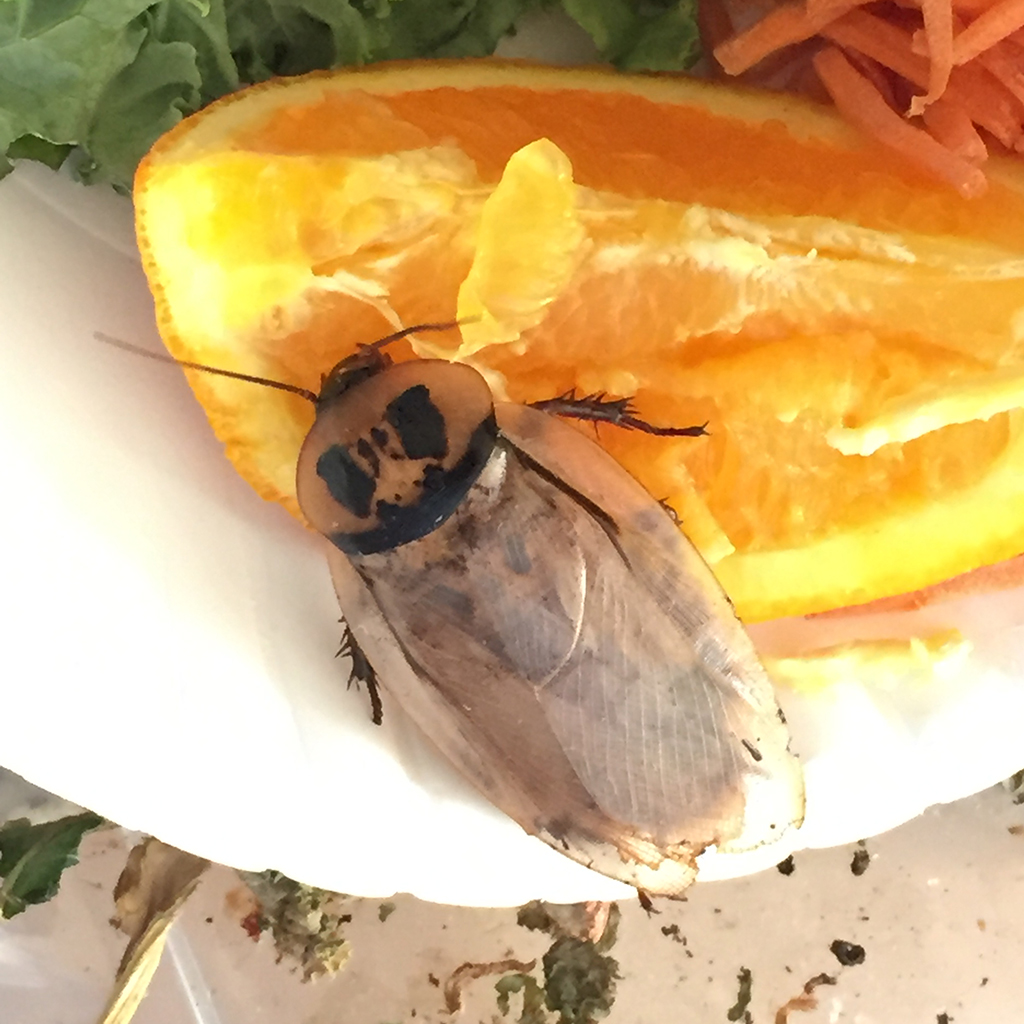Summary: Feeding Your Chameleon
- Chameleons eat live food
- Chameleons are insectivores but will take vertebrate prey
- Chameleons need variety in their food
- Beware of obesity. High quality – low quantity
- Feed smaller prey items rather than larger
- It is not necessary to feed veiled chameleons plant matter
- Remove uneaten food items from cage
What do Chameleons Eat in the Wild?
In the wild chameleons will eat anything that can be caught and eaten. This includes any number of insects, arthropods, and even small vertebrates including lizards, birds, and mammals. What is important for us to realize is that chameleons in the wild are getting an incredibly diverse diet. Each insect species will have a different plant they feed on, each bee that is eaten will have pollen from a different flower, and there are rich stores of nutrients that are in baby lizards and birds which are not found in insects.
What do Chameleons Eat in Captivity?

In captivity we have only a shadow of the diversity found in the wild. But it behooves us to take advantage of what we have. There are commercially available crickets, roaches, flies, beetle larva, hornworms, silkworms, and the list goes on. Reptile keeping has grown to the point where we have feeder businesses catering to us. Each continent and state will have their own blend of available insects. The key is to use as many as possible.
Nutritious food is one of the important skills you will develop in chameleon keeping. You will develop skills in keeping different kinds of insects and feeding them to put them in top health and nutritional value. Although variety is recommended, quality is more important. Even if you feed only on type of feeder insects you may keep a chameleon into old age if you are diligent in making sure the crickets, or whatever staple feeder is available to you, are gutloaded with a nutritious feast before being fed. Most keepers combine gutloading and feeder variety.
How Often Do I Feed My Chameleon?

We love watching chameleons eat and we equate food eaten with health. But, like anything, too much of a good thing is no good. There are health problems that are associated with obesity – especially with females – so we must feed carefully. The best approach is to feed them as much as they will eat until they are full grown. At that point you scale back to 2-3 appropriately sized food items every other day. The next question is when they are full grown. And this is difficult to say definitively in an article. Each chameleon will grow at a different rate depending on the environmental and social conditions around it. The good news, at least with male chameleons is that it really doesn’t matter when they hit adulthood and if you over shoot. Once you see signs of your chameleon getting chunky you can pull back and bring the weight back in line. This threshold is crossed when they start growing in width rather than length and height. You will start to see the fat pads in their casque or head expand and bulge. Obviously, the signs will be different in every species. In the specific species profiles/ care summaries I will discuss what this means for each of those species.
Special Cases:
Gravid Females. Any female that is actively gravid or pregnant you can feed as much as she will eat.
Female Veiled Chameleons. Female Veiled chameleons are a very special case. They mature at an incredible rate and you need to be very careful that you do not create an obese female or else every egg laying will be life threatening. The most common cause of egg binding is a direct result of being fed too much. Their body will produce many more eggs than in nature and the fat pads in their hindquarters will grow to the point where they obstruct the egg laying process. It is important to read the care sheet on Veiled Chameleons where we go into more detail. There you will learn where to look for excess fat deposits. Veiled Chameleon females, under optimal conditions, can have their first clutch at six months of age. It is very easy to have them producing such large clutches at 6 months old that it is a threat to their health and life. This is why we have to be so careful. There are members of the chameleon community working on the “recipe” for how much to feed female veiled chameleons growing up and what temperatures to keep them at (the hotter they are the more they grow and the more “energized” they are)
The podcast episode below is especially for keepers of female veiled chameleons. I talk with Mari Joki who is one who is experimenting with diet vs heat to find a way to keep female Veiled Chameleons healthier. We don’t have the answers yet, but we are working on the answers!
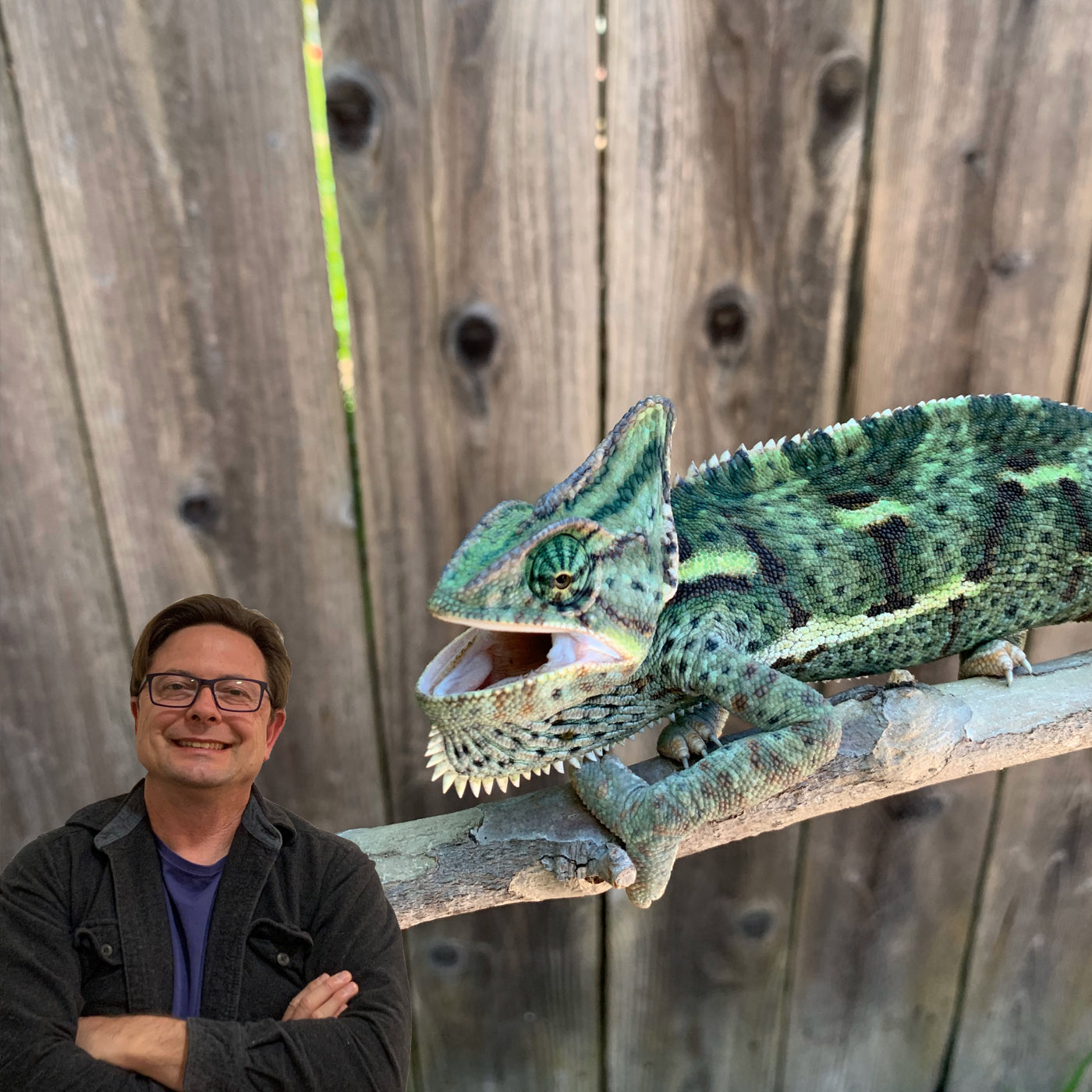

Bill Strand
Female Veiled Chameleon Feeding
Why is my chameleon a picky eater?

I want to discuss this from the beginning. We tend to over feed our chameleons. Once you get involved with any community you will hear over and over about chameleons that are picky eaters and refuse anything but certain favorite foods. This is almost always a result of over feeding. The chameleon is not eating because it is not hungry. And it only eats if the food is a favorite. It is just like us. when we are full we do not feel like eating much at all. But there is always room for ice cream!
If you chameleon starts refusing food then first, go to the schedule published above. If they still turn their nose up at what you feed them then skip a feeding or two until hunger comes back. A healthy chameleon can easily go a week without food. They can go longer in times of hardship, but a week without food is usually enough to get them back to a state where they eat because they are hungry. Once you break the hunger strike then continue to feed in a sparse manner.
There is another possibility if your chameleon is eating, but refuses to eat a certain type of feeder. They may have a bad memory with that feeder. Perhaps they got bit or it didn’t taste good. So if your chameleon is eating staple foods, but refuses a certain food, then there is something about that particular food.
How Do I Feed a chameleon?
Properly gutloaded feeder items are placed in a cup or bag that has the proper supplementation and given a tumble to coat the insect with the powder. These feeder insects are then put in the cage with the chameleon. A good standard is to feed insects that are as long as the chameleon’s head is wide. We tend to want to feed them as big of food items as they can gulp down. The better approach is to feed smaller food items and just give them a couple more.
There are a variety of methods to feed your chameleon. The three main approaches are Feeder Run/Bowl Feeding, Controlled Release, and Hand Feeding.

Another thing to take under consideration is how long you leave your feeders in with your chameleon. Ed Kammer of Kammerflage Kreations gives some advice that he uses in his breeding operation.
Ed Kammer
Feed only the number of insects that will be eaten in 30 min
Feeder Run Feeding
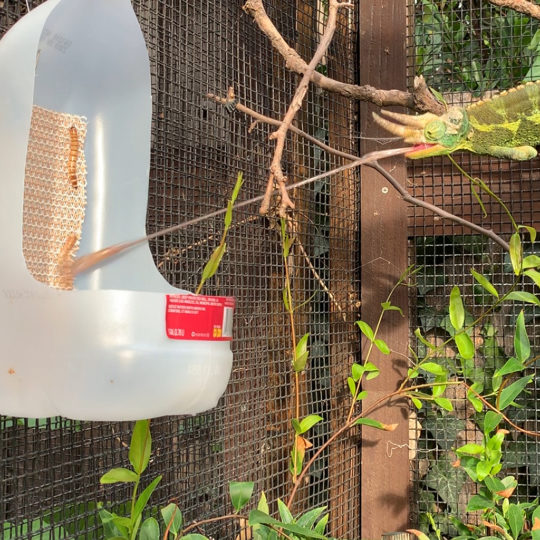
Bowl feeding is where you place a container in the chameleon cage where the feeders cannot get out, but the chameleon has a clear shot for its tongue. These can be as simple as bowls or plastic mini tote boxes with a branch network above. A Chameleon Feeder Run Cup is a modification on this idea where a vertical side is extended so the feeder insects will climb up and be much more visually stimulating to get the chameleon’s attention. These can be made cheaply or else nicer professionally produced versions are available.
Controlled Release
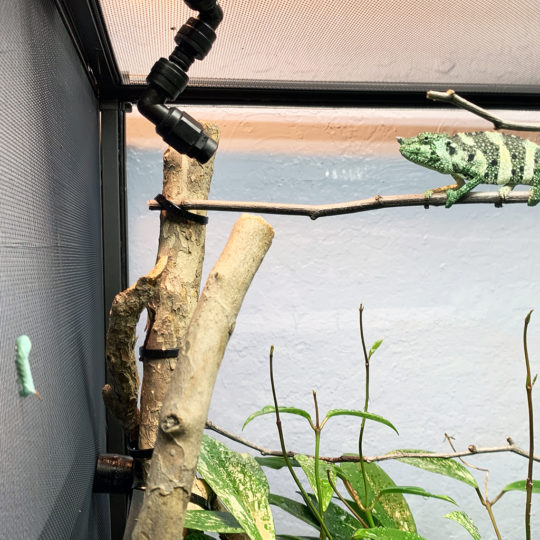
This is where you release one or a couple of feeders up the screen side of the cage. The insects scatter and you chameleon hunts them down. This is the method of choice for chameleons that just don’t embrace a bowl feeding. Though this is also a way of insects hiding and coming into contact with poop.
To produce a hunting response, feeder insects are released in the cage for the chameleon to hunt down. Usually this takes the form of releasing the insects to climb a wall that is near the chameleon. To do this I place my feeders in a deli cup that has the appropriate mineral/vitamin powder, gently shake to get a coating of powder, and then tip the cup up against the screen side of the cage. I sometimes give a tap to get the feeders to go to the cup opening. The feeders will generally start climbing the screen and you just let them climb up. I do this in tongue range of the chameleon, but as far away from him as possible. Ideally, this is done below him and the feeders are allowed to crawl up the screen. Doing it below him will make the activity less stressful as chameleons have a security when they are looking down on things. The main challenge with this method is the stubborn feeders that decide they want to climb down. Dubia roaches can have this tendency. Of course, you can simply place the feeder on the screen with your fingers and let it go.
Adjust your application as needed!
Hand Feeding

Hand feeding is an enjoyable interaction you can have with your chameleon. It is a way to get him to be comfortable with your presence. Do this with a special feeder treat and hold the treat between you and the chameleon. This way, your chameleon is not distracted by having to keep one eye on you and one eye on the feeder.
Vertebrate Prey
Chameleons will take vertebrate prey such as lizards, pinkie mice, and small birds. If it moves, and can fit in their mouth, then it is fair game. Depending on the size of your chameleon, occasional vertebrate prey is a benefit. Obviously, the larger the chameleon the more likely that they will eat another lizard or even pinkie mouse. We generally don’t make a regular occurrence of feeding vertebrates, as you could easily give their bodies too much of a good thing. But an occasional feeding of an appropriately sized vertebrate is acceptable. There is no determined schedule as to how much is too much. A bi-monthly vertebrate feeding has worked well for me for my larger chameleons. If you are unsure, then stick with an insect diet. You cannot go wrong with that choice.
Eating Leaves and Plant Matter

A very few chameleon species will eat the leaves of the plants in their cage. Most notably, the veiled chameleon. There are many ideas as to why they do this. Nutrition and hydration really don’t make sense considering what they eat and when they eat it in the wild. The one explanation that does make sense is that they use the leaves as roughage to help their digestion. This idea was put forth by Petr Necas as he observed veiled chameleons in Yemen eating leaves when there was ample food and water around. Their poop showed leaves undigested, but wrapped around the poop. This made sense because, as babies, they would eat a great deal of caterpillars and roughage was needed to pass the soft waste.
In captivity, there is no need to feed vegetation and, especially, do not feed fruit. This has been a common practice, but not for the right reasons. Veiled chameleons are programmed to eat anything and everything to grow up as quick as possible before the dry season comes and kills them all. Just because they eat something doesn’t mean it is good for them.
But, if your chameleon does take bites out of your cage plant then do not worry. It is just nature’s programming. With the exoskeleton feeders we feed in captivity our veiled chameleons are not as dependent on roughage. They apparently had no need, in the wild, to ever not eat plants. The cynical among us would point out that that is the effect of living only one season. Living for years is a new dynamic on their evolutionary development. But this does highlight that if you have a veiled chameleon, replace any plastic plants with real plants as plastic leaves may be eaten and cause health issues. Since the veiled chameleon does not have much in the way of discernment, we need to make accommodations. Pothos (Epipremnum aureum) has been shown to be a safe plant for veiled chameleons to live with and nibble on. Though it is listed on the dog and cat toxic lists as toxic due to oxalates in the leaves, decades of veiled chameleons eating them without an issue tells us that either the shortened throat of the chameleon is immune to oxalates or that Veiled Chameleons do not eat enough to be affected.
Summary:
1) Use live plants, especially with Veiled Chameleons
2) Do not feed fruits to your chameleons
3) Don’t worry if your Veiled Chameleon chomps on your plants. This is natural.
Uneaten Food
Remove uneaten food after 30 minutes. All of your gutloading and supplementation dusting efforts go to waste if the insect is eaten after it is starving and has lost its coat of powder. With some feeders there is a chance of the feeder biting the chameleon. For many reasons, it is best to remove the feeders if they are not eaten. And do not put the feeders back in the feeder bin with all the other insects. The feeder may have picked up a pathogen or parasite in the chameleon’s cage and you do not want that spread around. These feeders should be destroyed and not reused. This is especially true of feeders that have had any contact with poop. This is the exact way that parasites rely on to be spread. Your goal is to have everything you offer be eaten. If you are constantly having uneaten food then it is time to reduce the number of feeder insects offered.
Navigation
This seminar is part of the introductory course Chameleon Basics which, in turn, is a module within the even larger Term 1: Getting Started With Chameleons.
In the next module we will study how to make the feeder insects as nutritious as possible. When they come to us from the reptile food supply company they are usually fed enough to be alive. It is up to us to gutload and supplement them to make them worth eating.

